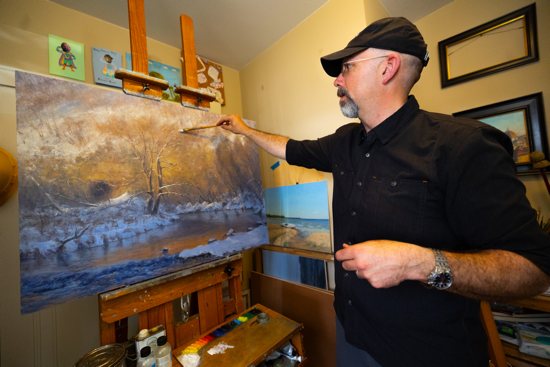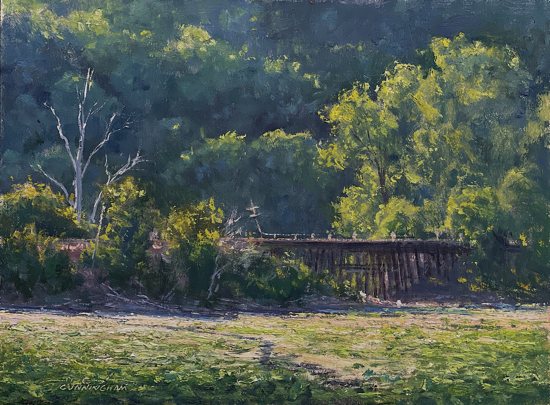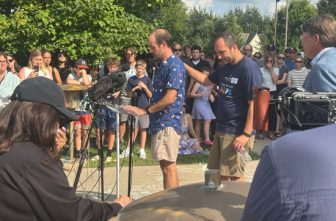
Applying his oil paints on a 9-inch by 12-inch canvas, plein air painter Joshua Cunningham explored how a beaver path cutting through vegetation and algae at Pickerel Lake in Lilydale visually opened up the shoreline, providing “an interesting leading line … weaving its way through the lily pads.” The lily pads appeared to him as if “they are giving praise, because their ‘palms’ are kind of cupped up.”
These observations come naturally to Cunningham. “In almost every place, the paintings feel like an invitation and me showing up, just like showing up to Mass, or showing up to adoration,” said Cunningham, 48, a member of Nativity of Our Lord in St. Paul. “The painting is the fruit of the connection between me and that place and me walking in faith as best I can that day in that place.”
Plein air painting — or the process of painting outdoors — is often about paying attention to how the “abundance of light, air, color, things that change” all go together, Cunningham said. Though the scene before Cunningham on a summery August morning was one he’s witnessed many times, the changes the landscape undergoes year by year offer him “more than I would ever be able to paint in a lifetime.”
After scouting his location by the side of the road just before 8 a.m., he set up a Pochade box on a tripod, lining the box with dozens of brushes. An umbrella connected to the Pochade box shaded his painting and oil paints while he worked. Cunningham laid out, and mixed, his paints according to a prismatic palette; Frank Vincent DuMond, the artist who developed it, taught that looking at a natural scene was like looking through a prism, or a rainbow of colors.
Cunningham paints original works; he does not make prints. He sometimes relies on a photograph to continue his work in his St. Paul home studio. When he works outdoors, he said he’s not physically moving much beyond a 5- to 6-foot space for three to four hours at a time. His setup becomes “a little hermitage.”
An Isanti native, Cunningham grew up in the middle of five male siblings; an experience he described as “a rough and tumble world.”
“We grew up doing sports and camping and fishing and we had woods and pasture and fields and a crick,” he said.
Growing up on 60 acres of former farmland, Cunningham said “the seeds were planted” for painting. His interest in art started with drawing, including making his own comics and drawing the animals he encountered outside.
In 1993, Cunningham began studying art, then criminal justice at St. Cloud State University before transferring to Metropolitan State University in St. Paul to pursue law enforcement. It was during this time that his youngest brother, Ryan, died in a car accident. Six months after that, Cunningham injured his back to the degree that future law enforcement work became unlikely.
“So, I’m broken inside and out,” Cunningham said. He started drawing again, because “there was nowhere else to put some of those feelings.”
“My faith kind of blossomed in that space,” Cunningham said. “I just wanted to be closer to my brother and that’s where I felt I was going to do that.”
Recognizing how much Cunningham had gone through, Shirley Wanchena — founder of Pacem in Terris in Isanti, who was a friend of the family — extended an open invitation to him to stay at the hermitage, which was just a couple miles down the road from where Cunningham grew up.
ARTIST HIGHLIGHTS
Plein air painter Joshua Cunningham’s work is featured in private collections throughout the United States and a few in Europe, according to his website.

His piece “So Begins the Green” received the PleinAir Magazine award in the 16th International Art Renewal Center Salon Competition, with an awards ceremony held in July. Thousands of artworks are entered each competition, according to ARC — which is a New Jersey-based arts educational nonprofit that hosts what it calls “the largest online museum.”
Cunningham’s work has also gained recognition through inclusion in the Oil Painters of America’s national juried exhibition, which seeks to recognize oil paintings that excel in craftsmanship, composition and color usage, among other criteria.
He was selected to participate in the Artist at Pine Needles residency program by the Science Museum of Minnesota. According to the museum’s website, the program allows visual artists and writers to spend several weeks at the James Taylor Dunn Pine Needles Cabin, north of Marine on St. Croix, and explore the connections among art, science and natural environments.
He estimates that he ultimately went on about four retreats at the hermitage; he reflected on his path, on his uncertainty about the future. “In my not-knowing, I just went to prayer with those questions over and over and over and over. And it wasn’t so much that I was getting answers, or at least that I could discern. The asking was honing, and it was changing me and softening me and cleaning out my ears so I could hear.”
Cunningham returned to his studies, this time at St. John’s University in Collegeville. He pursued an art degree while studying theology; he considered entering seminary. Cunningham felt his time at St. John’s was spent “rebooting” his pursuit of art “through a lens of faith.” It was “the difference of looking at things from one point of reference — mine — or an eternal reference point.”
A spring break visit to Pacem in Terris led to an encounter with the hermitage’s artist in residence, Mark Balma. Balma suggested that Cunningham help him with studio tasks during summer break. The rest of the school year, Cunningham said, he “barely touched the ground” because of his excitement. That summer of 1999, he apprenticed with Balma and ultimately didn’t return to St. John’s University, instead becoming “totally immersed” in art.

Balma “opened up this world of art I didn’t even know existed,” Cunningham said.
Before Balma stepped away from studio teaching, he encouraged Cunningham to consider two art schools: the Atelier Studio Program of Fine Arts in Northeast Minneapolis and the Florence Academy of Art in Tuscany, Italy — both provide education on a classical approach to art.
Cunningham was accepted to both at the time he met his now-wife, Shannon. At that point, he thought maybe his pursuit of art was what led him to Shannon. “If it only led me to the love of my life … what a gift.” Grant funding to help support his dream of attending the Florence Academy of Art fell through; Shannon continued to encourage his artistic pursuits and Cunningham continued studies at the Atelier Studio Program of Fine Arts.
After two years, Shannon encouraged Cunningham’s interest in another school: Hurinenko and Paquet Studio in St. Paul’s Lowertown neighborhood. Jeffrey Hurinenko taught portraiture and Joseph Paquet taught landscape painting.
Cunningham learned from Hurinenko and Paquet without considering whether he might ultimately become a plein air painter. Landscape painting was simply “something I thought would be good to know,” he said; it became “a gift I never expected to open.”
He began absorbing more from Paquet, who Cunningham recalled once said, “‘I’m not going to show you how to paint trees or the water, I’m not going to show you how to paint a house or any of that.’ He says, ‘All those things will be painted but we’re going to talk about the light of the day. We’re going to paint the day.’” Cunningham said this helped him observe the subtleties that make each day different and develop an appreciation for every day that this kind of observation cultivates. “You feel privileged to be there,” taking in the scene, Cunningham said.
By the time his two children, Greta — who graduated this spring as valedictorian from Cretin-Derham Hall high school in St. Paul — and William — who is a junior at Cretin-Derham Hall — arrived, Cunningham was bringing them with him to scout outdoor painting locations, as he focused on fatherhood and painting full time.
Now, Cunningham recognizes the interaction of art and mystery. “There’s a reason they call it art and not craft, because you don’t know until it’s over whether it will work out. I’m sure there’s a big life lesson in there, too.” For Cunningham, painting — and perhaps the life lesson — is about “making the next best decision … and then you make that choice. And if you make it well, it will lead you to the next thing.”
Faith guides Cunningham through those decisions; he relies upon it when fears of failure creep in, when it becomes “hard to own the gift that is available because you don’t necessarily feel worth it.” Faith becomes a way of “mending and healing into a place to feel like you’re worthy of the gift that has been given.”
As the sun moved across the August sky, Cunningham layered paint on the canvas, at times balancing his brush hand on his opposite arm as he painted a trestle bridge’s details and shading. Bicyclists glided past. One stopped, asked if he could observe, and did so for a time before pedaling off again. Stops from passersby happen often, Cunningham said. Mostly, he said, those interactions are about “listening to their stories.”
“I’ve had people pray with me, and it started with a ‘hello,’ and tell me incredible stories of their own faith, and that all started because I was here, and they were there.” Over the years, Cunningham has come to view the conversations as part of his process.
Reflecting on what his art might convey, Cunningham hopes “if I do well by what’s given me to paint, it will touch people so specifically to their own lives. … It will tumble into their life and stir up their memories and faith and experience in ways I could never ever have predicted or anticipated. And so all that’s required, not unlike prayer, is to show up and do your best with the time you’ve been given.”
UPCOMING EVENTS
Plein air painter Joshua Cunningham has award-winning artwork at Red Wing Arts’ Depot Gallery in Red Wing and Groveland Gallery in Minneapolis this summer, as part of the gallery’s 50th anniversary celebration.
In August, Cunningham is teaching a three-day plein air workshop through the White Bear Center for the Arts in White Bear Lake.
In September, Cunningham will be part of “Flora and Fauna: The Plein Air Experience 2023” at the Minnesota Marine Art Museum in Winona. He’ll be doing a plein air painting demonstration on Sept. 29 with other artists and his work will be exhibited.
The first weekend of December, Cunningham will open a solo show, called “Time Taken,” at Groveland Gallery; the exhibit will include 20 to 30 of his latest paintings.
Cunningham’s website can be found at joshuacunningham.com.



